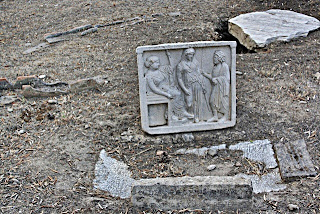Within the site are the ancient walls of Athens and the Sacred Gate which was only used by pilgrims from Eleusus using the sacred road to and from that site during the annual procession. Nearby is the Dipylon gate which was the main entrance to the city, where the Panathenaic procession began and where the cities prostitutes congregated so they could make themselves available to weary travelers. It was from this spot that Pericles gave what was probably his most well-known speech honoring those who had died in the first year of the Peloponesian war.
Kerameikos Cemetery
Kerameikos Cemetery
Grave Markers
Grave Stones
Grave Markers













































































